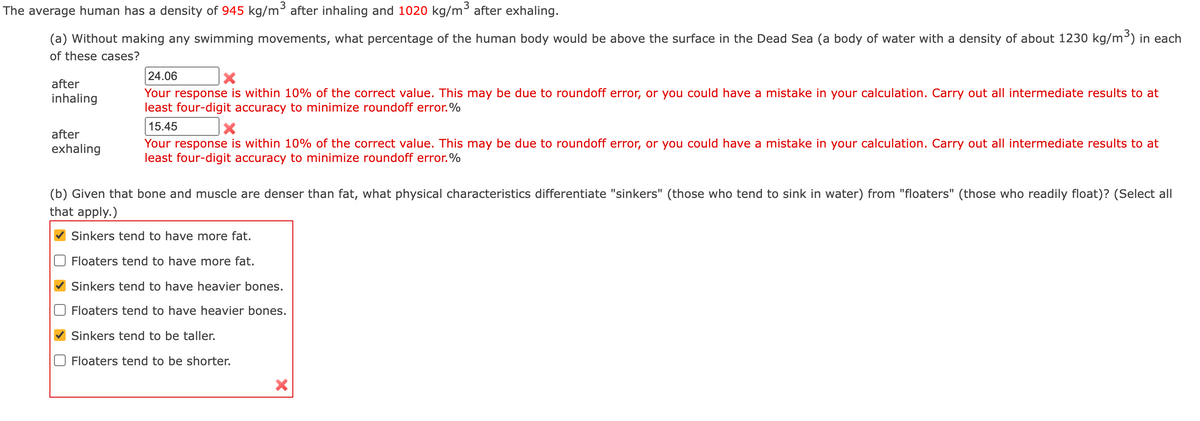The average human has a density of 945 kg/m after inhaling and 1020 kg/m³ after exhaling. (a) Without making any swimming movements, what percentage of the human body would be above the surface in the Dead Sea (a body of water with a density of about 1230 kg/m3) in each of these cases? 24.06 after inhaling Your response is within 10% of the correct value. This may be due to roundoff error, or you could have a mistake in your calculation. Carry out all intermediate results to at least four-digit accuracy to minimize roundoff error.% 15.45 after exhaling Your response is within 10% of the correct value. This may be due to roundoff error, or you could have a mistake in your calculation. Carry out all intermediate results to at least four-digit accuracy to minimize roundoff error. % (b) Given that bone and muscle are denser than fat, what physical characteristics differentiate "sinkers" (those who tend to sink in water) from "floaters" (those who readily float)? (Select all that apply.) V Sinkers tend to have more fat. O Floaters tend to have more fat. V Sinkers tend to have heavier bones. O Floaters tend to have heavier bones. V Sinkers tend to be taller. O Floaters tend to be shorter.
The average human has a density of 945 kg/m after inhaling and 1020 kg/m³ after exhaling. (a) Without making any swimming movements, what percentage of the human body would be above the surface in the Dead Sea (a body of water with a density of about 1230 kg/m3) in each of these cases? 24.06 after inhaling Your response is within 10% of the correct value. This may be due to roundoff error, or you could have a mistake in your calculation. Carry out all intermediate results to at least four-digit accuracy to minimize roundoff error.% 15.45 after exhaling Your response is within 10% of the correct value. This may be due to roundoff error, or you could have a mistake in your calculation. Carry out all intermediate results to at least four-digit accuracy to minimize roundoff error. % (b) Given that bone and muscle are denser than fat, what physical characteristics differentiate "sinkers" (those who tend to sink in water) from "floaters" (those who readily float)? (Select all that apply.) V Sinkers tend to have more fat. O Floaters tend to have more fat. V Sinkers tend to have heavier bones. O Floaters tend to have heavier bones. V Sinkers tend to be taller. O Floaters tend to be shorter.
University Physics Volume 1
18th Edition
ISBN:9781938168277
Author:William Moebs, Samuel J. Ling, Jeff Sanny
Publisher:William Moebs, Samuel J. Ling, Jeff Sanny
Chapter1: Units And Measurement
Section: Chapter Questions
Problem 1.7CYU: Check Your Understanding Figure 1.4 says the mass of the atmosphere is 1019kg . Assuming the density...
Related questions
Question

Transcribed Image Text:The average human has a density of 945 kg/m³ after inhaling and 1020 kg/m³ after exhaling.
(a) Without making any swimming movements, what percentage of the human body would be above the surface in the Dead Sea (a body of water with a density of about 1230 kg/m³) in each
of these cases?
24.06
after
Your response is within 10% of the correct value. This may be due to roundoff error, or you could have a mistake in your calculation. Carry out all intermediate results to at
least four-digit accuracy to minimize roundoff error.%
inhaling
15.45
after
Your response is within 10% of the correct value. This may be due to roundoff error, or you could have a mistake in your calculation. Carry out all intermediate results to at
least four-digit accuracy to minimize roundoff error.%
exhaling
(b) Given that bone and muscle are denser than fat, what physical characteristics differentiate "sinkers" (those who tend to sink in water) from "floaters" (those who readily float)? (Select all
that apply.)
Sinkers tend to have more fat.
Floaters tend to have more fat.
Sinkers tend to have heavier bones.
Floaters tend to have heavier bones.
Sinkers tend to be taller.
O Floaters tend to be shorter.
Expert Solution
This question has been solved!
Explore an expertly crafted, step-by-step solution for a thorough understanding of key concepts.
This is a popular solution!
Trending now
This is a popular solution!
Step by step
Solved in 2 steps with 1 images

Knowledge Booster
Learn more about
Need a deep-dive on the concept behind this application? Look no further. Learn more about this topic, physics and related others by exploring similar questions and additional content below.Recommended textbooks for you

University Physics Volume 1
Physics
ISBN:
9781938168277
Author:
William Moebs, Samuel J. Ling, Jeff Sanny
Publisher:
OpenStax - Rice University

Physics for Scientists and Engineers, Technology …
Physics
ISBN:
9781305116399
Author:
Raymond A. Serway, John W. Jewett
Publisher:
Cengage Learning

Principles of Physics: A Calculus-Based Text
Physics
ISBN:
9781133104261
Author:
Raymond A. Serway, John W. Jewett
Publisher:
Cengage Learning

University Physics Volume 1
Physics
ISBN:
9781938168277
Author:
William Moebs, Samuel J. Ling, Jeff Sanny
Publisher:
OpenStax - Rice University

Physics for Scientists and Engineers, Technology …
Physics
ISBN:
9781305116399
Author:
Raymond A. Serway, John W. Jewett
Publisher:
Cengage Learning

Principles of Physics: A Calculus-Based Text
Physics
ISBN:
9781133104261
Author:
Raymond A. Serway, John W. Jewett
Publisher:
Cengage Learning

An Introduction to Physical Science
Physics
ISBN:
9781305079137
Author:
James Shipman, Jerry D. Wilson, Charles A. Higgins, Omar Torres
Publisher:
Cengage Learning